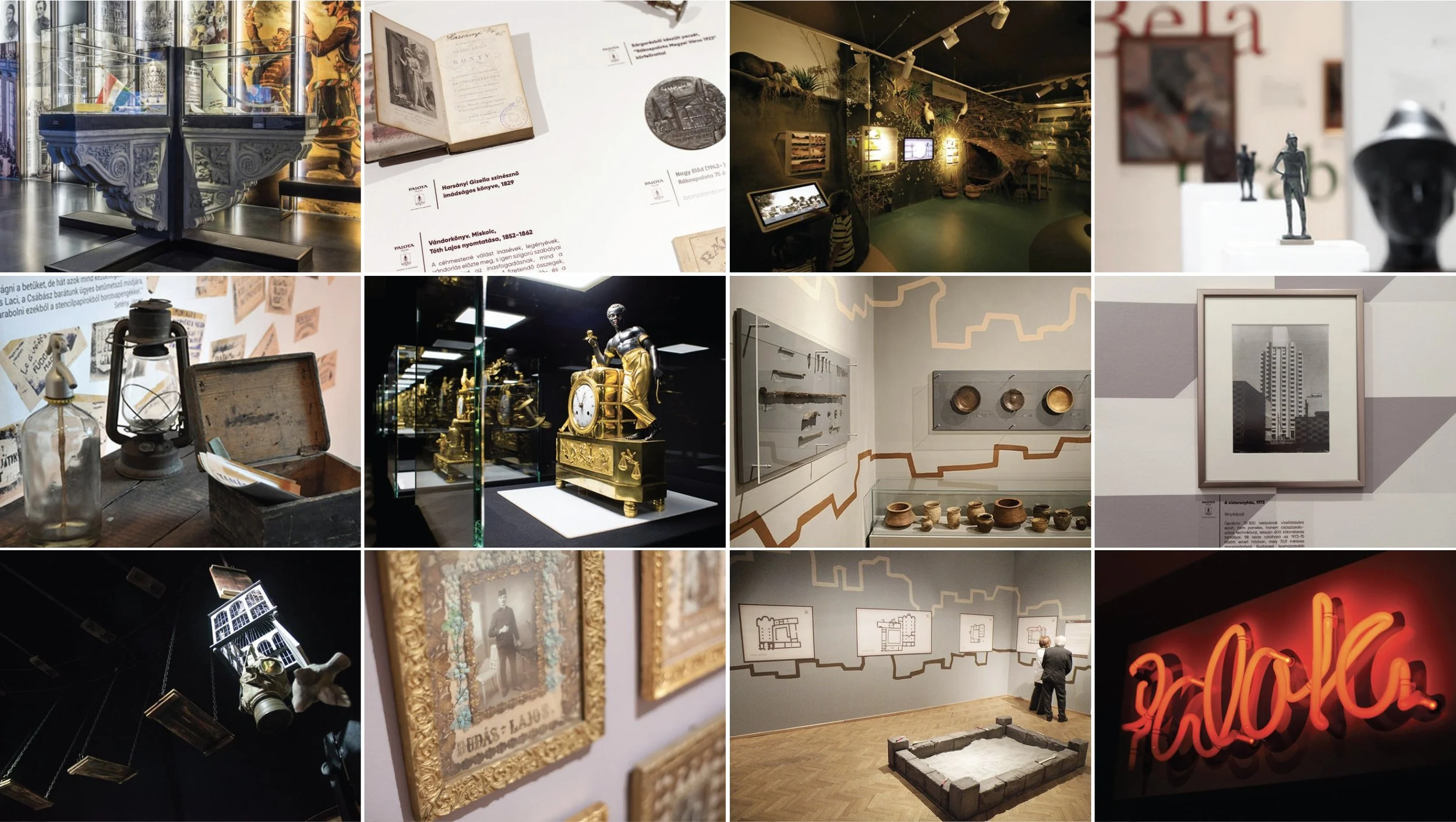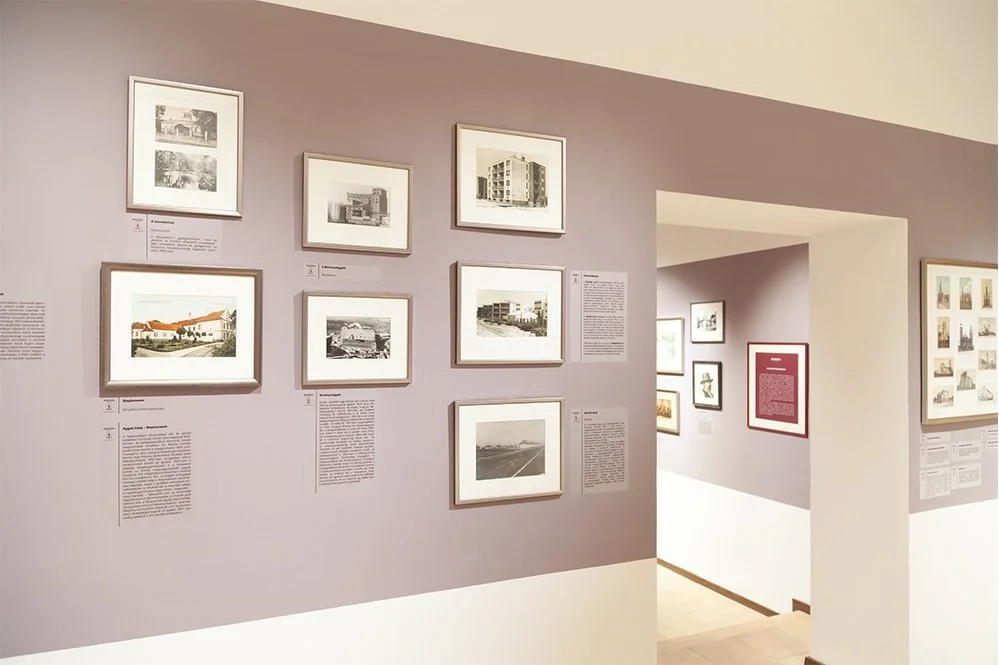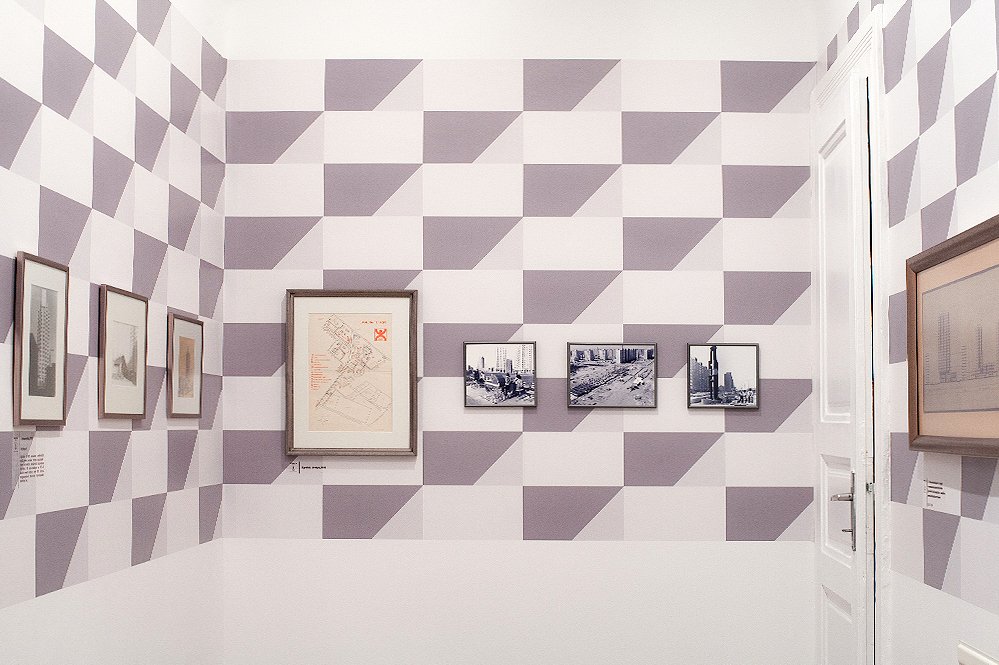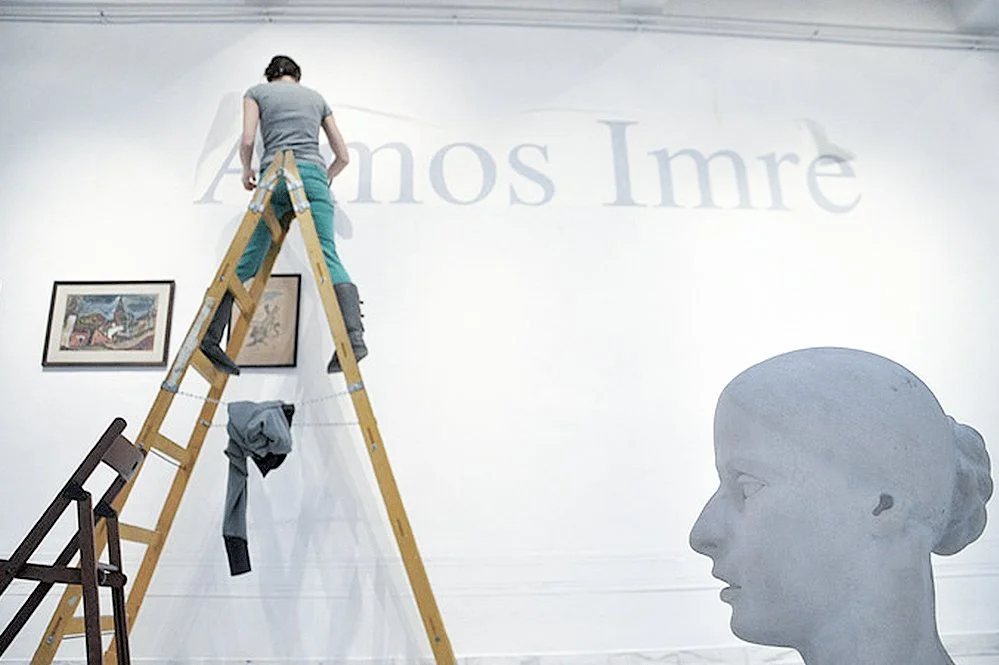Exhibition Design
This is one of my favorite fields. It is always a great pleasure and honor for me to be invited and to take part in the creation of a temporary or permanent exhibition, exposition place or museum. This is a very complex professional task, as you have to fulfill many criteria at once when designing an exhibition.
The most important aspect is, of course, the protection and handling of the artwork which is done by creating the appropriate display case, where not only the function, but also the aesthetic, safety, etc. conditions must be met. This is the real applied art, creating a harmony of function and design! And, of course, countless other tasks have to be solved in these cases: e.g. by creating and using the appropriate visual and graphic elements, the visual identity that best fits the theme of the exhibition must be created.
Walking routes should be developed and the exhibited information (e.g. in the form of infographics) needs to be made clear to the visitors. It needs to be adapted to the potential of the given space, it is important what kind of materials and colors or even screens are used, etc. And, of course, it is also important to take the budget into account…
Projects
On the Land of Palace
Ethnographic Exhibition
Original title: Palota Földjén - Hagyomány és sokszínűség
(On the Land of Palace - Tradition and Diversity)
Type: Ethnographic Exhibition
Responsibilities: Design & Execution of the Exhibition and Graphic Design Elements
Location: Museum of Rákospalota, Budapest, Hungary
Year: 2019
About the Exhibition: The past and present of the Palace district, which provide the basis for its future.
215 artifacts on 1800 square feet -paintings, graphics, photos, reliefs, artifacts, documents, relics.
Eszterháza Exhibition
Artwork Exhibition
Original title: Eszterháza Kiállítás
Type: Artwork Exhibition
Responsibilities: Execution of the Exhibition
Location: Esterházy Castle*, Fertőd, Hungary
Year: 2017
About the Exhibition: Collection of artworks of an ancient Hungarian noble family, the Eszterházy Family. Porcelain, clocks and paintings were exhibited valued at approximately $10 million.
*Eszterháza is a palace along Lake Fertő, that was made built by Prince Nikolaus Esterházy (and where Haydn, one the giants of music history, spent more than half of his active years as a court composer in the service of the Prince, so most of his masterpieces were born and presented within these walls.) The palace is also called the "Hungarian Versailles" and is the greatest Rococo edifice in Hungary.
Plural
Historical Traveling Exhibition
Original title: Többes számban - A Magyar Nemzeti Múzeum országjáró kiállítása
(Plural - Traveling Exhibition of Hungarian National Museum)
Type: Historical Traveling Exhibition
Responsibilities: Design & Execution of Graphic Design, Design of Digital Materials, Visual Design
Location: Hungarian National Museum and the main square of 9 other Hungarian cities
Year: 2016
About the Exhibition: The series of exhibitions complements the well-known history of World War I, making the everyday reality of the war easier to understand, among more than 700 original artworks exhibited.
House of Freedom
Historical Exhibition
Original title: Szabadság Háza
Type: Historical Exhibition
Responsibilities: Execution of the Exhibition
Location: House of Freedom, Békéssámson, Hungary
Year: 2015
About the Exhibition: In Békássámson, in the darkest years of the communist dictatorship, between 1951-1955 the most important Hungarian anti-communist organization of the era, the Hungarian Resistance Movement, was organized and operated. The exhibition goes through the history of the movement.
First Time Being Free - I ❤️ ‘90
Historical Exhibition
Original title: Először szabadon - I ❤️ ‘90
Type: Historical Exhibition
Responsibilities: Execution of the Exhibition
Location: House of Terror Museum, Budapest, Hungary
Year: 2015
About the Exhibition: The exhibition presents the first free parliamentary elections after the change of regime in Hungary in 1989. With this election, the process of political and legal transformation finally ended, and thus a new era began in the history of Hungary.
Virtuosos Talent Show
Musical Exhibition
Original title: Virtuózok
Type: Musical Exhibition
Responsibilities: Visual Design
Location: Castle Bazaar, Budapest, Hungary
Year: 2015
About the Exhibition: Virtuosos is the world's first classical music TV talent show. At the interactive music exhibition, the organizers aimed to bring classical music even closer to the audience.
“Enter His Gates”
Parochial Exhibition
Original title: “Mennyetek Be Kapuin”
Type: Parochial Exhibition
Responsibilities: Design & Execution of the Exhibition, Graphic Design Elements
and Digital Exhibition Enhancements
Location: Great Church of Debrecen, Debrecen, Hungary
Year: 2014
About the Exhibition: The Great Reformed Church in Debrecen is a major tourist attraction. The most important element of the exhibition on the ground floor is the original copy of the Vizsolyi Bible (1590), in the attic the old clockwork and the model of the church were exhibited among others. The exhibition is equipped with our self-developed digital exhibition enhancements as well.
Ancient-Drava Visitor Center
Natural History Exhibition
Original title: Ős-Dráva Látogatóközpont
Type: Natural History Exhibition
Responsibilities: Visual Design, Blueprint Creation, Design of Digital Materials
Location: Ős-Dráva Visitor Center, Szaporca, Hungary
Year: 2014
About the Exhibition: Visitors can learn about the natural values of the Drava River’s region and the cultural and historical values of Ormánság at the interactive exhibition of the visitor center.
Museum of National Assembly
Historical Exhibition
Original title: Országgyűlési Múzeum
Type: Historical Exhibition
Responsibilities: Design of Visual Identity and Digital Materials, Visual Design, Blueprint Creation
Location: Hungarian Parliament Visitor Center
Year: 2013
About the Exhibition: The Museum was established with the aim of collecting, preserving and presenting to the public the memories of Hungarian parliamentarism. The exhibition has been designed using traditional and multimedia museum techniques.
An Era Among Historical Traumas
Historical Traveling Exhibition
Original title: Egy korszak történelmi traumák között (1920-1944)
Type: Historical Traveling Exhibition
Responsibilities: Design & Execution of the Exhibition, Graphic Design Elements
and Digital Exhibition Enhancements
Location: 6 county museums, Hungary
Year: 2013
About the Exhibition: Culture and patronage in Hungary between 1920 and 1944, during the “getting back on their feet” era after the signing of the Treaty of Trianon, which ended World War I (and which annexed two-thirds of Hungary's territory!).
It gives a unique picture of the scientific improvements and culture of a quarter of a century.
During this period lived e.g. János Neumann, the founding father of the modern computer, Ede Teller, the inventor of the hydrogen bomb, Albert Szent-Györgyi, the exploler of vitamin C, and most of the leading researchers in the Manhattan Project*, e.g. Leó Szilárd, the inventor of the nuclear reactor, Tódor Kármán, the father of supersonic flight, Jenő Wigner, the improver of the theory of nuclei and elementary particles, etc.
*The Manhattan Project was a joint venture for the development of nuclear weapons during World War II, involving the United States, Great Britain, and Canada. President Franklin D. Roosevelt decided to launch it in 1942 on the initiative of the Hungarian Leó Szilárd (who was also supported by Albert Einstein).
Wheat-Bread-Life
Ethnographic Exhibition
Original title: Búza – Kenyér - Élet - A búza útja a földtől az asztalig egykor… és ma
(Wheat - Bread - Life - The journey of wheat from the earth to the table in the past… and today)
Type: Etnographic Exhibition
Location: Museum of József Katona - Cifrapalota, Kecskemét, Hungary
Responsibilities: Design & Execution of the Exhibition, Graphic Design Elements
Year: 2013
About the Exhibition: The exhibition uses the tools of museology to find the answer to what has made something that has been sustainable for millennia become unsustainable in a single century: wheat production and processing. A visitor to the entertaining, interactive, educational, spectacular, and even astonishing ethnographic exhibition becomes an active recipient by becoming amazed, remembering, touching, trying, comparing, searching, discovering, understanding.
Treasures of Monasteries
Archeological Exhibition
Original title: Kolostorok Kincsei
Type: Archeological Exhibition
Responsibilities: Design & Execution of the Exhibition, Graphic Design Elements
and Digital Exhibition Enhancements
Location: Cifrapalota, Kecskemét, Hungary
Year: 2012
About the Exhibition: An exhibition of archeological finds in the Southern Great Plain from 12th-13th century. The exhibition also presents bowls of sin and virtue, secret seal, a belt buckle decorated with a griffin bird and a tile full of hundreds of years old children's drawings. Visitors could also walk in the belfry of a cloister or virtually enter a monastery.
OMIKE Art Action
Art Exhibition
Original title: OMIKE Művészakció
Type: Fine Art Exhibition
Responsibilities: Design & Execution of the Exhibition and Graphic Design Elements
Location: Dohány Street Synagogue*, Budapest, Hungary
Year: 2011
About the Exhibition: On the eve of World War II, laws restricting the lives of people of Jewish origin were introduced in Hungary. From 1938 onwards, institutions and events were established to “parry” the effects of these laws, such as the OMIKE group, who launched their Art Action in October 1939 with the aim of keeping Hungarian Jewry at the cultural level it had reached so far and on the other hand they wanted to provide Jewish artists, writers, and musicians with work and income, who were initially “just” expelled from institutions previously open to them as a result of the restrictions of Jewish law, and later most of them unfortunately lost their lives during the Holocaust.
*The Dohány Street Synagogue, also known as the Great Synagogue, is the largest Jewish house of worship in Europe.
Battle of Mohács, 1526
Historical Exhibition
Original title: Mohácsi csata, 1526.
Type: Historical Exhibition
Responsibilities: Design & Execution of the Exhibition, Graphic Design Elements
and Digital Exhibition Enhancements
Location: Mohács Historical Monument, Mohács, Hungary
Year: 2011
About the Exhibition: The National Memorial of Mohács fittingly presents to the visitors one of the most important historical events of the Hungarian people, the Battle of Mohács*, in the framework of an interactive exhibition.
*The Battle of Mohács took place near Mohács on August 29, 1526, between the armies of the Kingdom of Hungary led by King Louis II and the Ottoman Empire led by Sultan Suleiman I the Great. The battle ended with an overwhelming Ottoman victory, as a result of which Hungary was divided into three parts. 150 years of Turkish rule followed in the southern and central parts of the country. The northeastern part of the country became the “colony” of the Habsburg Empire and after that for a long time preserved the existence of Hungary only in its name. Only the eastern, Transylvanian territories were able to retain their independence. For this reason, our later historiography referred to this day as "the great cemetery of our national greatness."
Magazine of Women
Fashion Exhibition
Original title : A világ női szemmel (The World through Women’s Eyes)
Type: Fashion Exhibition
Responsibilities: Design & Execution of Digital Exhibition Enhancements
Location: VAM Design Center, Budapest, Hungary
Year: 2010
About the Exhibition: The retro exhibition “The World through Women’s Eyes” commemorates the last sixty years. Those visitors can bring the past to life through articles in the Women's Magazine* (original name: Nők Lapja), with the help of emblematic and newspaper-depicted objects.
*The Women's Magazine is a weekly iconic Hungarian women's magazine. It was founded in 1949 and is still Hungary's leading women's magazine.
Country of Opportunities
Historical Traveling Exhibition
Original title: A lehetőségek országa - Polgárosodás a 19. századi Magyarországon
(The Country of Opportunities - Embourgeoisement in Hungary in the 19th Century)
Type: Historical Traveling Exhibition
Responsibilities: Design & Execution of the Exhibition, Graphic Design Elements
and Digital Exhibition Enhancements
Location: 1 Highland* and 5 Hungarian county museums
Year: 2010
About the Exhibition: The exhibition series focuses on the concept of “citizen”. Citizen, citizenship - these terms have been heard and used especially a lot since the 1989 regime change. But do we know what it is, what they mean? How has the important role of citizenship in industry, commerce, science, culture and public life developed? The exhibition presents this process through six dynastic stories.
*Highlands is a field of mixed population of Hungarians and Slovaks. For 1,000 years it was the northern border region of historic Hungary, which was separated from Hungary after World War I as a punishment. It is now called Slovakia and it is a separate country.
Bürger of Buda
Historical Exhibition
Original title: Budai Bürger, Pesti Polgár - Polgári értékrend, polgári mentalitás a 19. századi Pest-Budán (Bürger of Buda, Citizen of Pest - Civic values, civic mentality in 19th century in Pest-Buda*)
Type: Historical Exhibition
Responsibilities: Design & Execution of the Exhibition
Location: Budapest History Museum - Buda Castle, Budapest, Hungary
Year: 2010
About the Exhibition: It follows the development of the social history of the bourgeoisie in the period between the end of the 18th century and the unification of the city. This was the period when the foundations of the concept of citizenship in today's sense were laid.
*Today's Budapest - the capital of Hungary - was formed from the “building together” and merging in 1873 of three originally separate cities: of Pest built on the right bank of the Danube and of Buda and Óbuda, built on the left bank of the Danube.
Spring Expedition
Historical Traveling Exhibition
Original title: A dicsőséges tavaszi hadjárat, 1849.
(The glorious spring expedition, 1849)
Type: Historical Traveling Exhibition
Responsibilities: Design & Execution of the Exhibition and Digital Exhibition Enhancements
Location: Hungarian National Museum (Budapest), Budapest History Museum (Budapest)
and 5 more Hungarian county museums, Hungary
Year: 2009
About the Exhibition: “Such a Spring was only once in my life” - The Glorious Spring expedition*, 1849, features 240 privately owned artifacts, each of which aims to present one of the most glorious stages in our history. What is special, however, is that the relics can be seen again in an interactive environment.
*The glorious spring campaign was one of the stages in Hungary's war of independence in the 1848-49 period to secede from the Habsburg Empire, which then ruled half of Europe at that time.























































